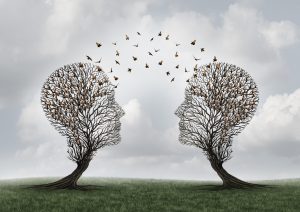
No matter how hard we strive to connect with others, there will always be an inexorable gap between our bodies and our minds and those of another. It sometimes seems to me that humans are destined to be alone with our singular consciousness. And yet, we exchange so much in the space between us. We may not be able to perform the Vulcan mind-meld, but there is a bridge across that gap.
Recent research in cognitive neuroscience reveals one process by which we influence one another. Mirror neurons are specialized cells that fire both in response to our own behavior but also in response to our observation of another’s behavior. Functional magnetic resonance imaging (fMRI) supports the idea that brain regions rich in these cells are similarly activated when we perform an action as well as when we observe someone else performing it. For this reason, mirror neurons are speculated to be involved in social learning, our ability to understand others, and our capacity for empathy. When we match people in tone and language – when we mirror them – we create alignment that promotes rapport and cohesion.
Bridges, however, can be used by invading armies as well as they can be used by caravans of laughing yogis. What do we share across this bridge? Emotions, for starters. Emotional contagion is the spreading of emotions from one person to others. Imagine sitting on a park bench with someone seething with rage. Now imagine sitting next to someone radiating joy. How does each scenario make you feel? Even in a brief visualization, the difference is palpable. We must be mindful that we aren’t spreading the plague but sharing more positive, effective emotions.
Emotional intelligence is the set of skills that allow us to be aware of our own and others’ emotions and manage and moderate them adaptively. Without it, we can ultimately damage relationships, not to mention the climate and culture of the social group in which we live and work. Once considered a “soft” (i.e., less important) skill, EI is being linked to other interpersonal processes, as well as to substantive “hard” outcomes.
Take the concept of psychological safety. Psychological safety is what it sounds like – feeling safe behaving authentically and willing to take risks within the context of a group or relationship. People who don’t feel safe engage in self-protective impression management. We don’t want to look stupid, so we don’t risk making mistakes or admitting our weaknesses. We don’t want to come off as pushy, so we don’t offer our ideas. We don’t want to be seen as negative or critical, so we don’t challenge the status quo. When people protect themselves in this way, they withhold – from themselves, their colleagues, and their organization – opportunities for learning and innovation. In this day and age, it is nothing short of a leadership failure to allow this to happen.
How can we as managers and leaders avoid this state of affairs? It comes back to emotional intelligence and to modeling effective behavior and emotional control. How do you respond when someone offers a critique? Are you angrily defensive, or open and responsive? How do you respond when someone makes a mistake? Do you lose your cool and lose perspective, or maintain perspective and focus on learning? Psychological safety grows from relationships built on trust and respect, which in turn require mature emotional responses in the face of inevitable adversities.
Self-awareness and awareness of how we affect others, we are finding, has farther-reaching impacts on team effectiveness, organizational culture, and innovation than we realized. It’s disconcerting, however, that research also suggests that power quashes the very capacity for mirroring that serves as the foundation for these skills. The antidote appears to be to find a way to stay grounded, so that the sense of being powerful doesn’t outpace the sense of humility.
The question of what we share across the spaces between us and how that exchange transforms us leads to a powerful paradox. Perhaps the crux of it is that power does not influence, share, or exchange. Power is about having and keeping and protecting what is mine. Power encourages us to take down the bridge, while influence invites us to cross it. Which do you choose?
